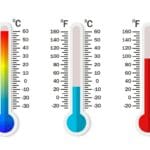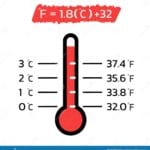Do you know at what temperature the human body operates at its peak? It is 36.6 celsius, but what does that temperature represent in Fahrenheit? Converting temperatures is a vital skill for understanding weather patterns and scientific experiments, and this link will guide you through the process of converting 36.6 celsius to fahrenheit.
Decoding 36.6°C: What’s That in Fahrenheit?
Let’s talk temperature! 36.6°C is a number you might see on thermometers outside the U.S., but what does it mean in the Fahrenheit world? It’s like translating between languages—both Celsius and Fahrenheit tell us about temperature, just with different words. This conversion comes in handy for everyday things, from checking the weather forecast to understanding your body temperature.
Celsius vs. Fahrenheit: Two Sides of the Thermometer
Imagine two rulers measuring the same length but with different markings. That’s Celsius and Fahrenheit. Celsius sets water’s freezing point at 0°C and boiling at 100°C—pretty straightforward. Fahrenheit, commonly used in the U.S., sets freezing at 32°F and boiling at 212°F. This difference often necessitates conversions, especially for body temperature.
Converting 36.6°C to Fahrenheit: It’s Easier Than You Think
The conversion formula is: °F = (°C × 9/5) + 32. Let’s plug in 36.6°C:
°F = (36.6 × 9/5) + 32
°F = 65.88 + 32
°F = 97.88
So, 36.6°C is approximately 97.88°F. Voilà!
36.6°C and Body Temperature: Is It “Normal”?
36.6°C (or 97.88°F) is often cited as “normal” body temperature. However, “normal” varies. Factors like age, time of day, and activity level can influence your temperature. A normal range is typically considered between 97°F (36.1°C) and 99°F (37.2°C). If your temperature isn’t exactly 97.88°F, don’t panic—it likely falls within a healthy range. If you’re concerned, consult a healthcare professional.
The Broader Importance of Temperature Conversion
Understanding Celsius-to-Fahrenheit conversion isn’t just about body temperature. It’s useful for baking (many recipes use Celsius), traveling to countries using Celsius, and understanding scientific experiments and weather.
| Celsius (°C) | Fahrenheit (°F) | Description |
|---|---|---|
| 0 | 32 | Freezing point of water |
| 20 | 68 | Room temperature (approx.) |
| 36.6 | 97.88 | Average body temperature |
| 100 | 212 | Boiling point of water |
Is 97.88°F (36.6°C) a Fever?
We’ve established that 36.6°C equals 97.88°F. But is that a fever? No. A fever is typically defined as 100.4°F (38°C) or higher. 97.88°F falls comfortably within the normal range. While individual normal temperatures vary, 36.6°C sits squarely within the typical healthy range. Ongoing research continues to explore the nuances of body temperature regulation, so our understanding of “normal” may evolve.
| Temperature (°C) | Temperature (°F) | Status |
|---|---|---|
| 36.6 | 97.88 | Normal |
| 37.0 | 98.6 | Normal |
| 37.5 | 99.5 | Normal (Upper End) |
| 38.0 | 100.4 | Fever |
| 38.5 | 101.3 | Fever |
Consult a healthcare professional if you have concerns about your temperature or other symptoms.
What Does 36.6°C on a Thermometer Really Mean?
A 36.6°C reading on an oral thermometer generally suggests a healthy body temperature. For adults, a healthy range is typically between 36.5°C and 37.5°C (97.7°F to 99.5°F). Body temperature fluctuates throughout the day due to factors like activity level, age, hormonal changes, stress, and the environment.
| Factor | Effect on Body Temperature |
|---|---|
| Time of Day | Lower in the morning, higher in the evening |
| Activity Level | Increases with exercise |
| Age | Tends to be lower in older adults |
| Hormonal Changes | May cause fluctuations, particularly in women |
| Stress | Can cause a slight increase |
| Environment | Affected by extreme heat or cold |
While 36.6°C is often considered average, individual variations exist. Research suggests genetic factors might influence baseline temperatures. If your temperature exceeds 38°C (100.4°F), accompanied by other symptoms, consult a doctor.
Is 36.3°C (97.34°F) a Fever?
Converting 36.3°C to Fahrenheit using the formula °F = (°C × 9/5) + 32 gives us 97.34°F. This temperature is not a fever. A fever is generally considered 100.4°F (38°C) or higher. While 97.34°F is on the lower end of the normal range (97°F-99°F or 36.1°C-37.2°C), it’s still within healthy parameters. Individual baselines can vary, and other factors can influence body temperature. Consult a healthcare professional if you’re experiencing other symptoms or have concerns about your temperature.
| Temperature | Celsius (°C) | Fahrenheit (°F) | Is it a Fever? |
|---|---|---|---|
| Freezing Point of Water | 0 | 32 | No |
| Boiling Point of Water | 100 | 212 | No |
| Normal Body Temperature (Low End) | 36.1 | 97 | No |
| Normal Body Temperature (High End) | 37.2 | 99 | No |
| Fever Threshold | 38 | 100.4 | Yes |
| Our Example Temperature | 36.3 | 97.34 | No |
Ongoing research may refine our understanding of “normal” body temperature. While current guidelines are helpful, consult a healthcare provider for personalized advice if you have any concerns. This information is for general knowledge and does not replace professional medical advice.
- Unlocking 2-Letter Words with U: The Definitive Guide - April 4, 2025
- Unlock Words with the Letters THREE: Top Unscramble Tools 2025 - April 4, 2025
- Master Scrabble: X & Z Words for High Scores - April 4, 2025
















